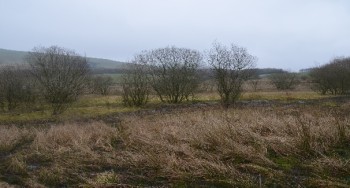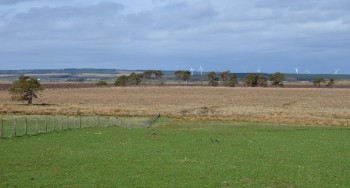Supporting guidance for Management of Buffer Areas for Fens and Lowland Bogs
Date published: 30 November, 2018
For recent changes to this guidance, please see the bottom of the page.
Both fens and lowland bogs are types of wetland. This option aims to support their management by increasing the water levels and reducing nutrient inputs on land immediately adjacent to, and into the bog or fen.
Wildlife benefits
Fens
Fens are fed by surface water and / or groundwater, as well as direct input from rainfall. These wetland habitats support a variety of animals and plants such as wetland birds, amphibians, sedges and rushes.
They are characterised by high soil water levels for all or part of the year, and are often based on peat. The quantity and quality of water feeding into fens plays a major role in determining the type of fen, its vegetation and wildlife.
Fens can be acidic or alkaline, depending on the water entering them, associated soil types and the vegetation which grows on them.

Unmanaged fen on the edge of a lowland bog – Credit: Tony Seymour – © TFE 2014

Intensively managed grassland next to a lowland bog. Management of lower slopes of the field as a buffer zone would include the areas of rushy pasture – Credit: Tony Seymour – © TFE 2014
Lowland bogs
These occur in the Scottish lowlands. They are recognised by gently sloping domes of peat. Initially peat is formed from decaying fen plants, filling the depressions on which the bog sits.
Once the peat is above ground level the vegetation is dominated by bog species such as Sphagnum moss. These bog plants continue to form peat and the bog dome slowly builds up above the surrounding land.
Over thousands of years peat can accumulate to a depth of many metres.
Because the surface of the bog is raised well above the influence of groundwater, the vegetation is dependent almost entirely on rain and snow for its source of nutrients.
Only plant species specially adapted to live in such waterlogged, nutrient-poor conditions can survive, and this results in a specialised plant community.
The vegetation is usually dominated by bog mosses, heathers and cotton grasses.
Fen vegetation is commonly associated with lowland bogs. When they were first formed, many lowland raised bogs would have been surrounded by an area of fen vegetation, called a lagg fen.
Lagg fens are fed by a mixture of nutrient poor water seeping from the bog and more nutrient-rich water from the surrounding area.
In many cases the areas of lagg fen have been drained or improved but where they do occur together, the management of both bog and fen habitats is often linked, although their requirements may be different.
Location and size of the buffer area
We recommend that the buffer area that you manage is at least 10 metres wide. It may need to be wider depending on the gradient, soil type and management of the surrounding land.
We suggest you contact Scottish Natural Heritage to agree the location and extent of the buffer area and any associated capital works to improve the condition of the fen or bog.

Appropriate grazing levels can increase the structural diversity of the vegetation and the creation of a fine network of pools, without over-grazing and poaching – Credit: Tony Seymour – © TFE 2014

Active partnership between Scottish Natural Heritage, adviser and farmer to identify the most appropriate management for the bog site – Credit: Tony Seymour – © TFE 2014
What needs to be done?
- establish a buffer area next to a fen or bog habitat to give these features additional protection from more intensive farming activities
- graze the buffer area with livestock. Your grazing management plan should also describe your grazing regime for both the buffer area and, where appropriate, the adjacent fen or bog
- graze the buffer area to control the build-up of rank vegetation and encourage structural diversity within the sward and across the site
You can also use the buffer to help manage any grazing you undertake on the bog or fen. Because livestock preferentially graze the more productive ground, a buffer can help to maintain livestock condition and maintain a light grazing pressure on the adjacent bog or fen.
Your grazing regime will be affected by the composition of the sward, your management objectives, and the environmental conditions.
On sites with very dense vegetation cover, such as dense cover of soft rush, you may find you need to cut the vegetation (as well as graze it) to control rank growth.
We recommend you discuss your proposals at an early stage with an Scottish Natural Heritage Area Officer to help you prepare a plan.
Re-wetting the buffer area
Re-wetting the buffer area can help to reduce water losses from the bog or fen.
Where a buffer area is connected to a bog or fen, blocking ditches and breaking field drains within the buffer can help to reduce water losses from them.
Water flows within the buffer area can also be managed to reduce the direct flow of sediments, nutrients and chemicals onto the bog or fen.
Where the buffer area is next to a bog or fen, bringing water to the surface within the buffer area will reduce the direct flow of water, sediments, nutrients and chemicals into them.
This may be done by breaking field drains and culverts within the buffer area to encourage drainage water to flow across the vegetation in the buffer.
The vegetation can act as a filter reducing the risk of nutrient input from adjacent fields by sieving-out soil particles and by allowing plants and bacteria to take up nutrients from the water before they reach the bog or fen.
The creation of scrapes and pools downstream from the surfaced drains may also slow the flow of water and increase the effectiveness of the buffer as well as add to the diversity of habitats in the area particularly for dragonflies, amphibians and wading birds.
Establishment of vegetation on arable land
Further guidance on the selection and establishment of sown grass swards is available in the guidance for Creation of Buffer Areas for Fens and Bogs item.
Related capital items
- Wetland Creation – Field Drain Breaking
- Wetland Creation – Pipe Sluices
- Ditch Blocking – Plastic Piling Dams
- Ditch Blocking – Peat Dams
- Moving or Realigning Ditches
- Creation of Buffer Areas for Fens and Bogs
- Pond Creation for Wildlife
- Creation of Wader Scrapes
- Stock Bridges for Bog, Fen or Wetland Management
- Moving or Realigning Ditches
- Cutting of Rush Pasture
- Scare and Temporary Electric Fencing
- Stock Fence
- Gate
Further information
More detailed guidance is available from the Peatland Action page of the Scottish Natural Heritage website. This includes guidance on plastic piling, reinforced and peat dams, scrub control, grazing on peatlands and so on.
Additional information can be found at:
- Fen Management Handbook (Scottish Natural Heritage)
- Fens for Plants and Animals (Scottish Natural Heritage)
- Amphibian and Reptile Conservation Trust
- Ponds and scrapes webpage (Amphibian and Reptile Conservation Trust)
Recent changes
| Section | Change |
|---|---|
| Further Information | Links to Peatland Action, Fens for plants and animals, and Ponds and scrapes webpage updated |
| Further information | Fen Management Handbook updated |
